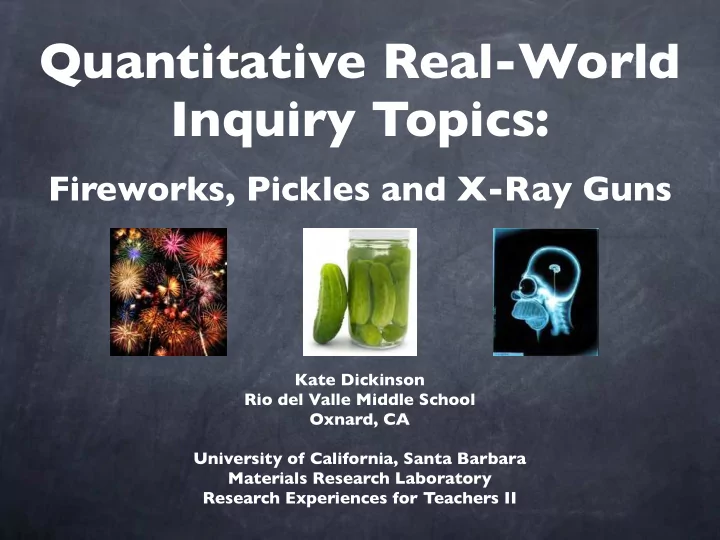

Quantitative Real-World Inquiry Topics: Fireworks, Pickles and X-Ray Guns Kate Dickinson Rio del Valle Middle School Oxnard, CA University of California, Santa Barbara Materials Research Laboratory Research Experiences for Teachers II
RET 1: Thin Film Fabrication and Morphology Studies of Blade Coated Organic Photovoltaics ITO Electrode 1. Light Absorption 2. Exciton Diffusion 3. Charge Separation 4. Charge Transport 5. Clean Energy Aluminum Electrode Courtesy of A. Ostrowski and B. Walker
RET 1: Thin Film Fabrication and Morphology Studies of Blade Coated Organic Photovoltaics • Studied P3HT:PCBM active layer fabrication parameters, film morphology and crystallinity using AFM
RET I to RET II • How do OPVs apply to an 8 th grader? • Big ideas of RET I • Photon absorption and charge transport • Conductivity of organic materials • Spectroscopic characterization
RET I to RET II OPVs 8th Grade Topic Lab Module Photon Atomic Flame Test Absorption Structure *EM Spectrum Periodic Table Solution Conductivity Bonding Conductivity Solar System Astronomical Spectroscopy Stars & Galaxies Spectroscopy
RET II Goals Atoms, periodic table, Turn qualitative ideas Primary Goal bonding, and astronomy into quantitative topics are very abstract, hands-on lab activities qualitative and intangible for a middle school • Accessible to middle school students student • Reading, writing, math AND science • Real-world applications • Student design and ownership Secondary Goals • Work within MY budget • Cover standards and prepare for CST
Flame Test, Flaming Pickles, Fireworks and EM Spectrum 1. Conduct flame test and quantify wavelength of three unknown samples Flame Test Color Estimated Solution # Description Wavelength (nm) Pink λ = 650 nm 1 Green λ = 530 nm 4 Blue λ = 480 nm 6
2. Calculate ν and E (modified c and h constants to make values more tangible) 3. Identify unknown samples based on calculated values Middle School Level High School Level Frequency (s -1 ) Frequency (s -1 ) ν = c = 3000 nm/s ν = c = 3 x 10 8 m/s λ 6.5 x 10 -7 m λ 650 nm ν = 4.61 s -1 ν = 4.61 x 10 14 s -1 Energy (kJ/mol) Energy (J/photon) E = ν h E = ν h E = (4.61 s -1 )(40 kJ s/mol) E = (4.61 x 10 14 s -1 )(6.626 x 10 -34 J s/photon) E = 184.6 kJ/mol E = 3.058 x 10 -19 J/photon Element Li B Na K Cu Sr Energy (kJ/mol) 181.2 228.6 203.4 279.1 252.6 190.5 3.369 x 10 -19 3.786 x 10 -19 4.185 x 10 -19 4.623 x 10 -19 Energy (J/photon) 3.012 x 10 -19 3.155 x 10 -19
4. Plot data and identify relationships between wavelength, energy and frequency 300 275 Energy (kJ/mol) 250 225 200 175 150 350 400 450 500 550 600 650 700 Wavelength (nm)
5. Apply new understanding to examine fireworks and FLAMING PICKLE experiment
Recommend
More recommend